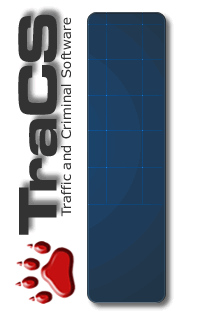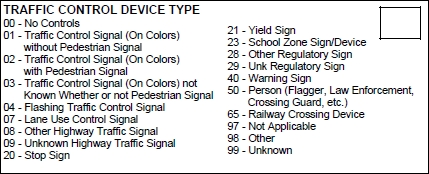

Select the option which best describes the traffic controls in the non-motorist’s environment just prior to this non-motorist’s critical pre-crash event. The roadway used for selecting an option for this field is the one this non-motorist departed from if it is off the roadway just prior to its critical pre-crash event. If this non-motorist is in a junction just prior to its critical pre-crash event, this field selection should be based on the roadway this non-motorist was on before entering the junction. Select the option if it directly matches.
Make a selection in this field whether the device was functioning or not. If more than one device was present, select the highest device (lowest number on list) most related to the crash. There are two exceptions:
- One exception is 50 - Person (Flagger, Law Enforcement, Crossing Guard, etc.) This option takes precedence over the entire list.
- The other exception is a 28 - Other Regulatory Sign. You may have a 28 - Other Regulatory Sign along with another traffic control device (for example, a warning sign for a dangerous condition in which the warning wign is more relevant in the crash). In this case, the 40 - Warning Sign is more appropriate to select.
When a traffic control is deactivated (e.g., traffic signal that emits no signals) during certain times of the day and was deactivated at the time of the crash, select 00 - No Controls. It is also appropriate to select this option when a traffic control has just been installed but not yet activated.
01 - Traffic Control Signal (On Colors) without Pedestrian Signal - refers to any highway traffic signal by which traffic is alternatively directed to stop and permitted to proceed, utilizing the colors of red, yellow, and green. This traffic control signal does not have a pedestrian control signal. The source of actuation is of no concern.
02 - Traffic Control Signal (On Colors) with Pedestrian Signal - refers to any highway traffic signal by which traffic is alternatively directed to stop and permitted to proceed, utilizing the colors of red, yellow, and green. This traffic control signal does have a pedestrian control signal. The source of actuation is of no concern.
03 - Traffic Control Signal (On Colors) not Known Whether or not Pedestrian Signal – any highway traffic signal by which traffic is alternatively directed to stop and permitted to proceed, utilizing the colors of red, yellow, and green. It is unknown if this traffic control signal has a pedestrian control signal. The source of actuation is of no concern.
04 - Flashing Traffic Control Signal - usually has a single colored head and flashes. Select this option if it is a Highway Traffic Signal that is flashing. This includes a flashing beacon. If a flashing red beacon appears with a stop sign, use this option.
Guide signs do not constitute traffic controls.
You may have a regulatory sign along with another traffic control device (for example, a warning sign for a dangerous condition in which the warning sign is more relevant in the crash). In this case, the warning sign is more appropriate to select.
Judgment must be applied with regard to the proximity of the device to the crash. Typical signs which create such problems are:
- Speed limit signs where a party to the crash may be speeding
- "Do Not Pass" signs where a no passing zone extends for miles but is only marked at the beginning of the zone
- Pedestrians Prohibited signs at entrances to freeways but a pedestrian crash occurs on the freeway between interchanges
- And other such signs which may pertain to a significant length of road.
Generally, the appropriate option should be used if a party to the crash failed to obey the sign, was in a position to be controlled by the sign, or the sign has some relationship to the crash. For example, for a crash at a four-way stop intersection where a driver fails to stop at the stop sign and collides with another vehicle, select the option 20 - Stop Sign. Conversely, at the same intersection, a driver on an approach not controlled by a stop sign loses control and strikes a utility pole. In this case, 20 - Stop Sign would not be appropriate.
Pavement markings are not considered traffic control devices.
07 - Lane Use Control Signal - is for permanent lane control electronic devices (e.g., overhead lights or "X" indicating lane open or closed for rush hour lanes, bridges or at tollbooths).
08 - Other Highway Traffic Signal - should be selected for traffic signals that are not covered in the previous options. Use this option when a school bus uses flashing lights to control traffic around the bus, regardless of any additional signs the school bus uses. For example, a school bus uses flashing lights and a stop sign on an arm to stop traffic around the school bus. This should only be used if the crash occurred during the time the sign was in effect.
09 - Unknown Highway Traffic Signal – select this option when the highway traffic signal is unknown at the time of crash.
20 - Stop Sign - is a traffic sign used to control vehicular traffic, usually erected at road junctions, that instructs drivers to stop and then to proceed only if the way ahead is clear.
21 - Yield Sign - indicates that a vehicle driver must slow down and prepare to stop if necessary usually while merging into traffic on another road but need not stop if the way is clear.
23 - School Zone Sign/Device - is used when the first harmful event occurred during the time the sign was in effect. If the sign was in effect, it does not matter whether or not children were present. Some 23 - School Zone Signs/Devices can be flashing, if this is the case, use this option before using 04 - Flashing Traffic Control Signal.
28 - Other Regulatory Sign - Regulatory signs inform highway users of traffic laws or regulations and indicate the applicability of legal requirements that would not otherwise be apparent.
Examples of Regulatory Signs other than 20 - Stop Sign or 21 - Yield Sign are:
- Speed Limit
- Turn Prohibition
- Do Not Pass
- Do Not Enter
- Wrong-way
- One-way
- Road Closed
- Hazardous Cargo
40 - Warning Sign - is used when it is deemed necessary to warn traffic of existing or potentially hazardous conditions on or adjacent to a highway or street.
Examples of Warning Signs:
- Work/construction cone related signs (lane shift, uneven surface, workers ahead, etc.)
- Changes in horizontal alignment signs (hill, curve, etc.),
- Road narrows,
- Divided road/divided road ends,
- Low clearance,
- Road surface condition signs (bump, slippery when wet, etc.),
- Traffic flow signs (merge, two-way traffic, no passing zone, etc.),
- This includes electronic warning signs such as portable signs, (e.g., attached to a vehicle), or stationary devices,
- Flashing lights on an approaching train.
65 - Railway Crossing Device - is used to control or warn vehicular traffic at a railway crossing.
Examples:
- Flashing Lights
- Wigwags
- Bells
- Cross Bucks
- 01 - Driver of a Motor Vehicle In-Transport,
- 02 - Passenger of a Motor Vehicle In-Transport,
- 09 - Unknown Person Type in a Motor Vehicle In-Transport or an
- 03 - Occupant of a Motor Vehicle Not In-Transport
99 - Unknown – Select this option if the traffic control device for this non-motorist at the time of crash was not known.